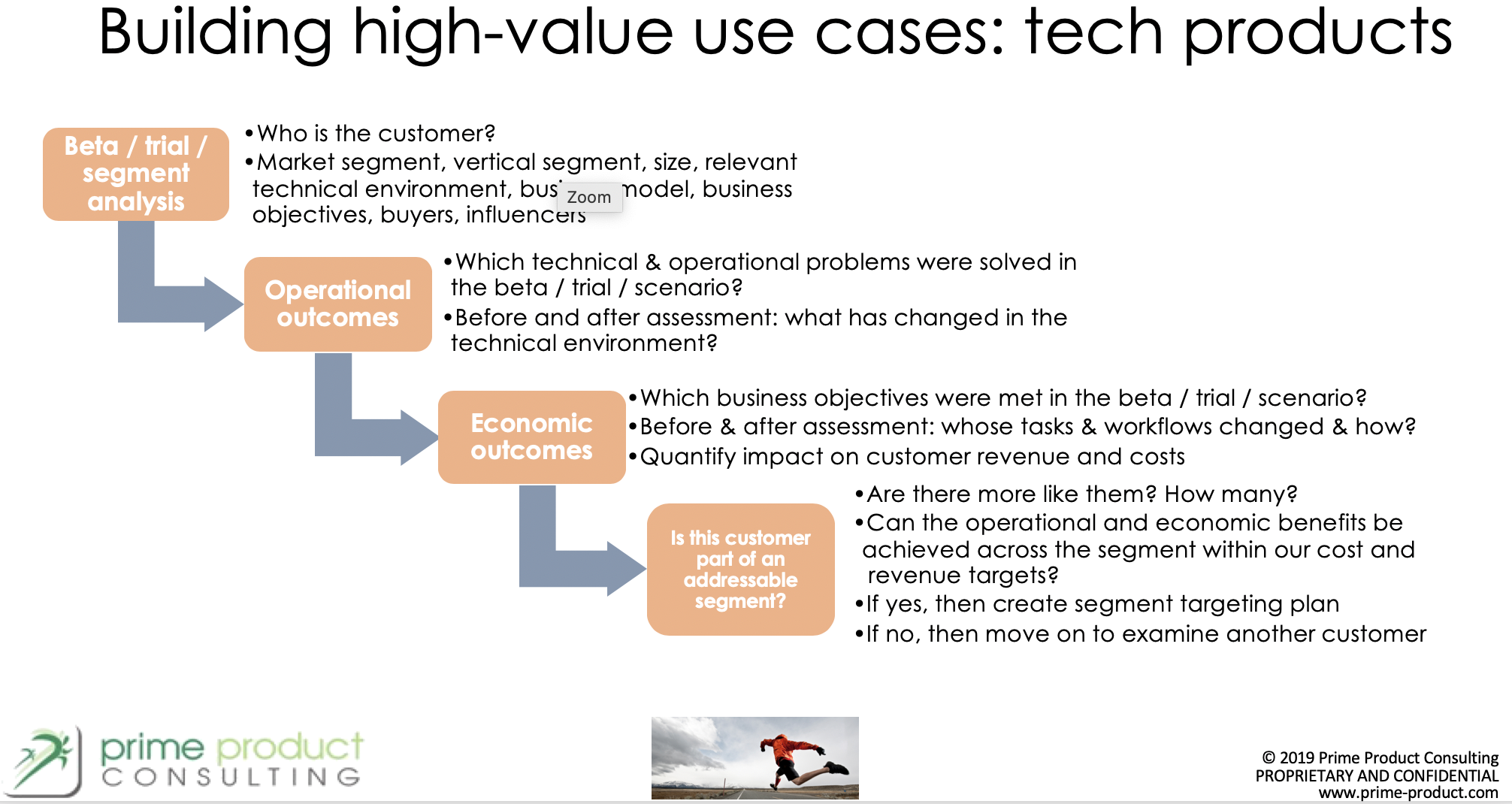Try to do everything and you end up doing nothing well.
That was the marketing strategy problem facing a startup I was working with a while back.
“Our platform is so flexible,” the head of products told me in so many words, “that we can solve just about any problem our target customers have.”
And so he and his team tried to do exactly that. They produced PowerPoint slides illustrating their solutions that looked like a wiring diagram for a jetliner.
Any customer on the receiving end of this “Slide Spaghetti” would be pretty much mystified. So I introduced this executive and his team to the template for building high-value use cases as a way to focus and execute.
How to Break Your Strategy
There are lots of names for this very common focus problem in technology marketing:
“Shiny object syndrome”… as in, you get distracted by and chase the next shiny object that comes along … you have a new strategy every week.
“Paralysis by analysis”… when you can never quite pull the trigger on a strategy because there is always more to consider … and maybe a better strategy will come along tomorrow.
“Failure to Focus” … when you forget that every activity, every penny spent, every meeting scheduled and every person hired should represent a measurable step toward your company goals.
“Fear of Missing Out (FOMO)” … when you are afraid of missing the solution that is going to spark the market demand explosion that catapults your company into the next Salesforce or Slack.
These four facets of the strategic focus problem are especially hard and potentially damaging when you are at a start-up.

Resources are limited, the clock is ticking and some investors are breathing down your neck, expecting you to make good on all that cool stuff in the business plan.
All of the facets of the problem are summed up very nicely by Michael Porter’s longstanding adage:
“The essence of strategy is choosing what not to do.”
In other words, make a plan and stick to it by making the hard choices of ruling out some of your options.
It means choosing your target market, understanding it, crafting the message and means of reaching it, and then executing, without changing all that marketing strategy a week later.
Fail Fast, Fail Often
But here’s the rub: Ruling things out today is very hard when it is so much easier to try out new things.
You can launch products and services with copy and paste digital marketing campaigns, leverage social media and search engine marketing, and measure in real-time how prospects are responding.

In fact, this approach is so tempting that “Fail Fast and Fail Often” is now a common mantra in some business circles.
The idea is that digital marketing and market awareness are easier to achieve, so you can throw a lot of things against the wall to see what sticks. When something does, you pour your resources into it.
Some business commentators have labeled Fail Fast and Fail Often “the stupidest business mantra of all time.”
Its value as a mantra might indeed be questionable from a business operational perspective.
But most definitely throwing anything and everything against the wall will confuse your market and lead you to be ignored by your prospects.
Stated another way, throwing every possible solution and message out into the market is asking your customers to sift through the mess and figure out what you do and if they need it. Almost no one will do that.
Marketing Template for Use Cases
In B2B technology marketing, the key to avoiding strategic focus failure is to use the advantages of digital marketing to iterate.
But you need to iterate narrowly, not making broad shifts in strategy.
The High-Value Use Case template is the process I used for the start-up I mentioned at the outset of this posting.
A Use Case is simply an example of how your solution will solve a particular problem for a particular type of customer.
It’s basically the same thing as a persona, a story, a storyboard, a scenario, and many other forms of narrative and problem definition that product managers and marketers use to clarify the value of a solution. A use case often reflects important steps in a customer journey.
The key is to use as much real-world data and experience as possible, based on beta customer exposure or other early stage discussions with possible customers. That type of engagement and feedback can be achieved by soft launches, requirements interviews, beta trials, pilots and so on.
A “high-value” use case is one in which you have broken down the application of your solution into its economic impact. Which use cases have the best return on investment or business case for your customer?
The output of this process then is a prioritization of which market sub-segments, solutions, messages, and go-to-market partners you should tackle, and in what order.
Building the High-Value Use Case
The diagram illustrates the workflow of this marketing template.

An essential first step is to engage with your customer audiences and gather as much real-world data on how the solution can solve essential problems in their environments. This can occur via requirements gathering, customer interviews, beta trials, customer support activity, early stage sales engagement and so on.
One of the challenges is that this data may reside in a bunch of different heads in your organization. So the Use Case process should bring all these people and sources of data together to focus around building out a scenario and use case for each segment.
If you can thoroughly describe the user, their business model, their segment, and how they learn about solutions like yours, then you can move on to step two.
At the next steps, your goal is to quantify as much as possible the technical or operational impact and the economic impact of your solution. The goal here is to understand, from the customer’s point of view, exactly what the solution will do and how that affects the customer’s costs, or revenues, or both.
This can involve advanced techniques like value mapping, in which you trace the impact of a change in a given process and then all the other processes or operational aspects that touch that process.
The driving principle is to focus on building a “before and after” picture of the customer, to clarify what life is like before your solution and what it is like after.
During this process you will come across some surprises. You may find a different user in a given type of customer who has an even stronger need for your solution. Or you may realize that the economic justification for your solution in a given customer type is far less compelling that you originally thought.
After you have quantified the operational and economic impacts of the solution in this scenario, the last step is to examine market size and addressability. How many customers of this type are really out there? Can you deliver the solution to them profitably?

The end result is a prioritized list of target segments and customer types. You also have a great collection of data that will be used for marketing messaging, sales strategy, go-to-market planning and execution and so on.
But most importantly, you now have a clear and sustainable focus. You have aligned your team and resources around bringing to market the most valuable offerings for both you and your customers.
The process can be revisited periodically to make sure the earlier findings and analysis still hold. And this process means any changes in strategy must necessarily be based on real-world data and your team’s best analysis.
And you have eliminated the strategic focus problem and your team can stop chasing shiny objects.
Use Cases in Marketing Strategy
At Prime Product Consulting, we’ve helped many companies to focus their marketing strategies and launch new products that generate massive demand.
We can help your team build High-Value Use Cases, create digital marketing campaigns for demand generation, implement go-to-market strategy programs, execute Content Marketing for search engine optimization and thought leadership.
Contact us today to discuss how Prime Product can raise your Marketing Strategy to a new level.


Awesome post! Keep up the great work! 🙂